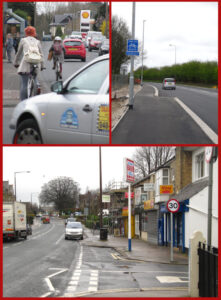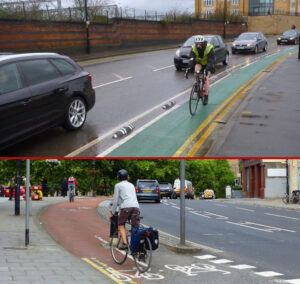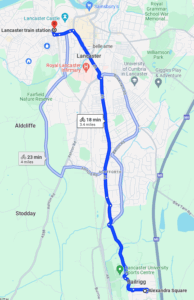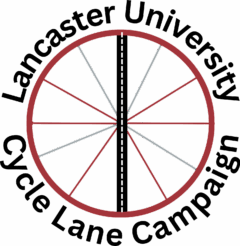The A6 is a dangerous road for cyclists. We need a segregated cycle lane! Back in 2024, we started a petition, asking the Lancashire County Council to make the A6 safer, and we collected 1412 signatures.
What is the problem?
- The A6 is the main road to the city centre. This is the main road for all transport getting in and out of Lancaster city centre.
- The A6 is the shortest road. It is the shortest and the most straight forward road between the city centre and the university.
- No proper cycling lane. There are some short stretches of red paint on the road for cyclists, but they are not consistent.
- Traffic is too close to cyclists. Because there is no proper segregated lane, cars drive too close to cyclists
This is how the A6 looks now

The A6 road between Lancaster and the university stands out as one of the most dangerous routes for active travellers according to an in-dependent audit conducted by the Road Safety Foundation. Currently, there are many problems:
- Dangerous parking:
- Parking bays force cyclists out of their normal path, placing them in the line of faster-moving vehicles.
- Passengers opening car doors unexpectedly have caused numerous injuries to cyclists.
- Parked cars obstruct visibility at junctions, making it challenging for drivers to spot approaching cyclists.
- High-speed traffic intimidation:
- Speeding vehicles along the A6 pose a significant risk to cyclists.
- Vehicles overtaking cyclists creates feelings of insecurity and unease.
- The lack of clear and continuous cycle lanes leads to confusion and potential hazards for cyclists.
This is how it should be

We should be able to cycle along the A6 road safely, without putting our lives or the lives of other road users at risk. Achieving this requires the installation of safe, segregated cycle lanes. We need:
- 1.5-meter-wide cycle lanes along the A6, stretching from Lancaster University campus to Lancaster Railway station.
- Either bollards, or a curb separating cyclists from the vehicles to prevent conflicts between different modes of transportation.
- Consistent continuous clear markings on the cycle lanes throughout the whole route to visually separate cyclists from the traffic.
Dedicated space for cyclists helps avoiding the need to maneuver around parked cars.
What do we propose specifically?

We propose creating a dedicated lane for cyclists directly from Lancaster University to the train station. This lane will offer students a quick and safe route to town and connect the train station in the city centre to the university.
To accommodate two 1.5-meter cycle lanes and two 3-meter vehicle lanes, ‘A’ roads need to be 9 meters wide. According to the County’s measurements, the road between South Rd and Booths supermarket is wide enough, except for a short stretch near St Paul’s Parish Hall. So, there is no fundamental obstacle for creating the segregated cycle lanes.
In a small city like Lancaster, cycling should be a top priority for transportation. Lancashire City Council’s declaration of a climate emergency in 2019 and 2020 commits to reducing carbon emissions, and promoting cycling can significantly contribute to this goal.
With around 13,000 students commuting between Lancaster campus and town regularly, along with many other road users, the A6 road is heavily trafficked, dirty, and unsafe for cyclists. Implementing safe, segregated cycle lanes along its busiest section is crucial for creating a healthy, safe, and accessible A6 road.
